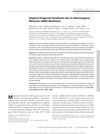Molecular Studies of Hutchinson-Gilford Progeria Syndrome
May 2009
in “
OPAL (Open@LaTrobe) (La Trobe University)
”
TLDR Suppressing the HGPS mutation may improve symptoms and suggest reversibility.
The study focused on Hutchinson-Gilford progeria syndrome (HGPS), a rare genetic disorder causing premature aging in children, with a median death age of 13 years due to myocardial infarction or stroke. Researchers aimed to understand the molecular mechanisms of HGPS, explore disease reversal possibilities, and develop methods to analyze LMNA transcripts. Using a transgenic mouse model, they found that the severity of the disease phenotype correlated with the level of transgenic expression. The study showed that suppressing the expression of the HGPS mutation led to significant improvements in skin and hair conditions, suggesting that the disease might be reversible. Additionally, they developed a method for quantifying LMNA transcripts, revealing that lamin C was the most expressed, while the lamin Adelta150 transcript was significantly higher in HGPS patients compared to controls. These findings provided insights into potential treatments and the molecular similarities between HGPS and normal aging.

